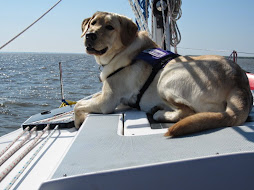Maybe you’re planning a summer vacation, or maybe you’re planning to visit distant family over the holidays. Or maybe you have to take a business trip. No matter what your plans, if you’re planning to travel by air and you have a service dog, chances are that you’re also planning on taking your service dog with you.
Although we try to take our puppies to the airport at least once, this may still be the dog’s first time on an actual flight. It may also be your first time flying with your service dog.
Here are some tips and other information for flying with your service dog. Even if you and your service dog are veteran fliers, we hope you’ll find these tips useful.
Packing for your flight
We suggest packing some extra food in your carry-on, just in case you get separated from your checked luggage. Also be sure to pack a bowl that can double as a water bowl and food dish.
Some people pack one or two of their dog’s favorite toys, which can be helpful if it’s a long flight. We recommend quiet toys. Save the squeaky toys for when you reach your final destination.
Booking your flight
Although many people book their flights online, it is often helpful to call the airport and let them know you have a service dog. By law, you cannot be charged an additional fee for your service dog, and they can travel in the passenger cabin with you.
By calling, you can also ask if the airport has any potty areas. Many airports are adding them, but not all personnel know where they are located, and those potty areas could mean the difference between a comfortable and an uncomfortable flight.
Before your flight
You never know how long you and your dog will need to be at the airport. Never feed your dog before your flight. You may also want to restrict their water.
At the airport
The following airport security tips come from the Transportation Security Administration website.
Make sure your dog is wearing his service dog harness, and if you have any additional identification for him, carry it with you.
When you get to security, let the Transportation Security Officer know that you have a service dog. You should be given the opportunity to move to the front of the line.
At any point of the security checkpoint, you may not be separated from your service dog, and your service dog does not need to remove his belongings, such as his harness or other equipment.
Make sure you set your dog up for success. Plan how you’re going to go through the metal detector. If your dog will be most successful going through with you, let the TSO know that that’s how you and your service dog will be going through. You can also have your dog to through first and you follow, or you can go through first and have your dog follow.
The TSO should ask your permission before touching your dog. When the TSO is conducting a search of your dog, you are in charge of controlling your service dog. Keep him calm and focused so the TSO can do his or her job.
Please remember that if you need to take your dog outside to potty, you will need to pass through security again.
Boarding
You and your service dog may be able to board your flight early. Make sure you get to your gate early, and let the gate agent know that you need to board early. Then make sure that you don’t go too far away so you are easily ready when it’s time for you to board.
On the plane
Your service dog will be able to ride with you in the passenger cabin, but you must make sure that he is tucked away safely. It is extremely important that he not block the aisle.
When you have your dog settled, it’s up to you to decide how you want to deal with people’s attention to the dog. You may have a seatmate or other neighbors who ask to pet the dog. Here is where you’ll have to do whatever will make your dog most successful. Some people ask their neighbors to ignore their dog until the very end of the flight. Other handlers may let people pet the dog as long as they stay in a down-stay.
Connecting flights
If you’re catching a connecting flight, try to make sure that you have enough time to get to your gate, and perhaps even take your dog for a potty break.
This is certainly not a comprehensive list of everything you need to know about flying with your service dog, but we hope you’ve found it helpful. If you have any other tips, please leave them in the comments.
Happy flying and safe travels!





























